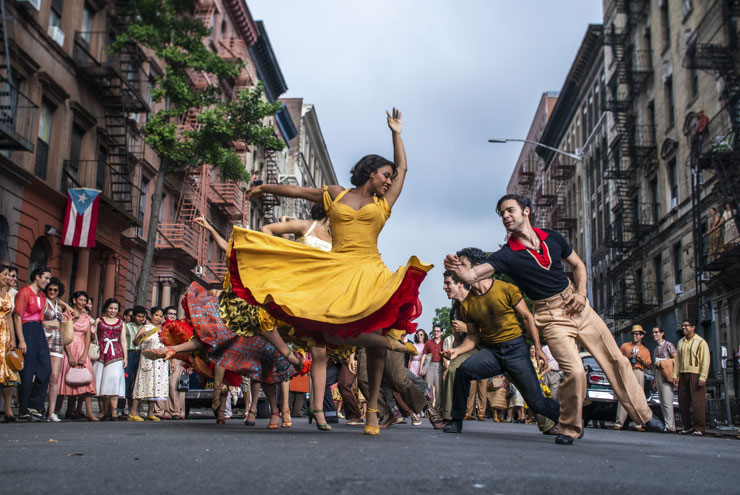
Ariana DeBose and David Alvarez in a scene from "West Side Story." (Photo courtesy 20th Century Studios.)
They're transfixed. As their eyes meet across a crowded school gymnasium, time appears to stand still for Tony and Maria. In that moment, it doesn't matter that he's an ex-con with ties to a street gang determined to drive their Puerto Rican rivals out of their turf. Or that her short-fused older brother is the leader of that rival gang. They introduce themselves behind the bleachers, and they just can't help themselves, as their faces draw closer, closer, closer.
The love-at-first-sight sequence in “West Side Story” is a pivotal moment, regardless of whether you're watching a stage production, curling up with a DVD or Blu-ray of the 1961 film, or feasting your eyes on Steven Spielberg's impeccably crafted new retelling of the venerated, but not without controversy, Broadway perennial.
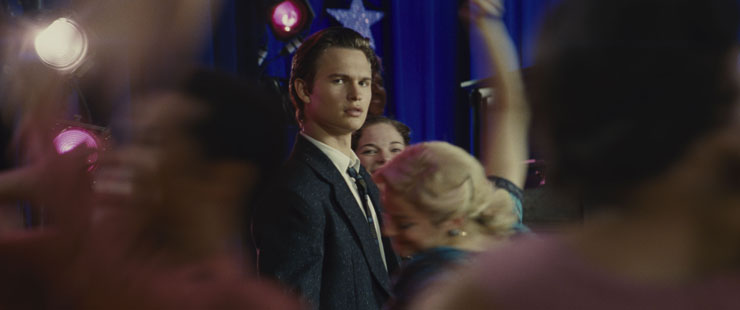
Ansel Elgort as Tony in a scene from "West Side Story." (Photo courtesy 20th Century Studios.)
And for all the skill and technical prowess on both sides of the lens, for all the God-level staging and camera placement on display, for all the laudable attempts to right past wrongs when it comes to representation and Hollywood's portrayals of Latin Americans, Spielberg is unable to pull off this seemingly simple thing: make us believe this boy and girl have fallen desperately in love.
Maria (Rachel Zegler) and Tony (Ansel Elgort) do kiss, briefly, behind those bleachers. And I felt nothing. No spark, no goose bumps, no shiver-inducing tingle. The odds are pretty stacked against a “West Side Story” where the chemistry between the leads is mild at best, nonexistent at worst.
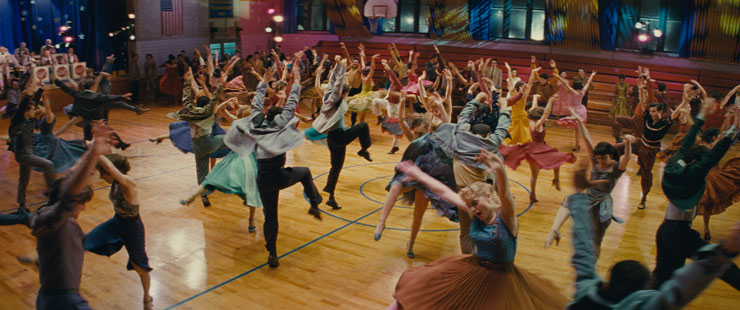
A dance sequence from Steven Spielberg's "West Side Story." (Photo courtesy 20th Century Studios.)
But in Uncle Steven we trust, and he pulls out all the stops in his attempt to deliver the goods in this polished awards season contender (and current box office underachiever). The Oscar winner frequently comes across here as a kid in a candy store, pleased as punch that he's finally able to shoot his first bona fide screen musical. It shows in the agility and verve of the musical numbers, a blend of Tinseltown artifice and urban grit that occasionally made me think of “42nd Street” (1933), that Depression-era classic from Warner Bros. widely regarded as the granddaddy of backstage musicals.
More so than its celluloid predecessor, this “West Side Story” brandishes an aggressive, alpha male energy. The gloves come off early. How early? Instead of the aerial shots of Manhattan that kick off the 1961 production, Spielberg hovers above debris and rubble, construction equipment claiming the streets like robotic colonizers in the process of driving working class people from their homes. San Juan Hill circa 1957 is dying, the filmmaker underscores with sobering precision, making way for a future that has no room for its current residents.
If the crumbling landscapes resemble a war zone right out of Spielberg's own combat films, that's because it is. The enmity between the (Irish, Polish American) Jets and the (Puerto Rican) Sharks doesn't start out as apparently harmless joshing between young men, as it does in Robert Wise and Jerome Robbins' Technicolor gem. Spielberg, working from a screenplay by frequent collaborator Tony Kushner, ratchets up the tension from the get-go. He stages a violent scuffle between the gangs like a director rejuvenated, melding elements from his earlier works with the intensity of his 21st century offerings. Old Spielberg, new Spielberg. The results are invigorating.
Even more so when the cops intervene, a confrontation that gives Kushner a chance to lay the groundwork from what this new “West Side Story” brings to the table: a pointed sociopolitical context that revels in the screenwriter's gift for storytelling and structure. This dialogue is rich, whether the characters are sizing each other up, trying to assimilate to the culture that now surrounds them or trying to prevent loved ones from getting into trouble.
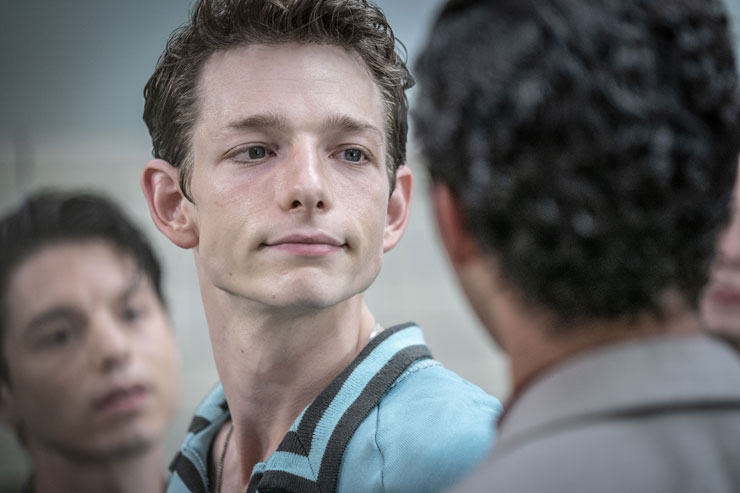
Mike Faist as one of the Jets in a scene from "West Side Story." (Photo courtesy 20th Century Studios.)
In two languages. You may have read about Spielberg's decision not to subtitle the considerable amount of Spanish spoken in the film, but this is actually one of his most inspired moves. It's actually closer to Spanglish: Spanish words peppered in sentences that tend to begin in English, delivered in shifting rhythmic flows that are almost as exciting as Justin Peck's choreography. Subtitles wouldn't have been able to keep up, but it's highly unlikely non Spanish speakers will be lost. Just go with it.
Kushner and Spielberg are bold enough storytellers to have Puerto Rican characters sing “La Borinqueña,” the Puerto Rican anthem, using the original lyrics, effectively turning it into a protest song. If only the filmmaking team exercised the same care when depicting the film's star-crossed lovers.
Maria, recently arrived from Puerto Rico (from one island to another), is trying to rise above her circumstances and the iron grip of her brother Bernardo (David Alvarez), a boxer (and the Sharks' leader) with a boulder on his shoulder. Tony, recently released from the slammer, is determined not to be pulled back into gang life. Individually, the characters are well delineated, even though Elgort's casting is perplexing. Spielberg has said the “Baby Driver” star has a quality that reminds him of the young Brando (closer to the young Tony Goldwyn from where I'm sitting), but his fashion-model good looks are an ill fit for Tony, a boy next door who ought to be a little rough around the edges.
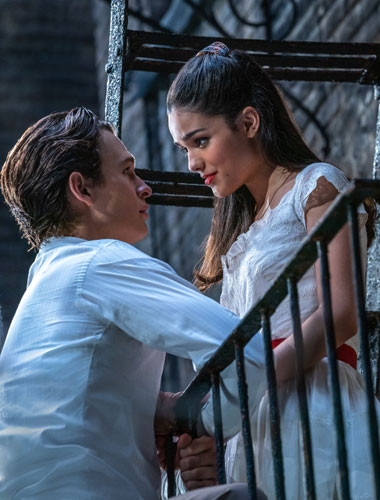
Ansel Elgort as Tony and Rachel Zegler as Maria in a scene from "West Side Story." (Photo courtesy of 20th Century Studios.
Spielberg works overtime to strike a match, but this affair is all wet, chaste in ways that feel almost abstract, especially whenever Kushner is overanalyzing the love birds' feelings and growing worries. Reality sets in: the romance at the center of this New York tale increasingly feels like a placeholder, a narrative thread that allows the far more assured depiction of gang warfare and urban unrest to unfold more fluidly. Those scenes brim with Francis Ford Coppola and S.E. Hinton vibes, and they show the director in stronger form than whenever he's having to deal Tony and Maria alone together.
And there's the rub. Romance is something Spielberg has struggled with throughout his career. I have a bit of a soft spot for “Always,” his 1989 remake of “A Guy Named Joe,” but one can almost feel the filmmaker becoming uncomfortable when it comes to depicting romantic intimacy. In “West Side Story,” this reticence rears its head at the worst possible moment, denying the young lovers the screen time that would have at least given them an opportunity to show a physical expression of their bond. But the director literally looks away.
With this unfortunate lack of heat, the supporting cast somewhat picks up the slack, most memorably Mike Faist, who gives Riff, the Jets' leader (and Tony's best friend) the charisma that's in short supply on Elgort's end, and Tony nominee Ariana DeBose is a marvel as Anita, Bernardo's dark-skinned better half. She delivers a line about national identity that's sure to bring the house down in Puerto Rican movie theaters. It's also nice to see Rita Moreno, Wise and Robbins' Anita, back on the big screen as Valentina, the widowed shop owner who has given Tony a place to work and a roof over his head. Elgort's scenes with the legendary actress are more engaging than any of the ones he shares with Maria.
So what we are left with is a tale of two movies: a bracingly revisionist portrait of class and prejudice where the animosity between people from different ethnic backgrounds is a symptom of a larger social ill: the Darwinian scourge of gentrification. Also, a 20th century retelling of “Romeo and Juliet” that pays tribute to not only its prior screen incarnation, but other film adaptations of Shakespeare's play. Most notable is one shot near the end, framed in a way that fans of Franco Zeffirelli's “Romeo and Juliet” (1968) will immediately recognize. There are also shades of Jacques Demy and Vincente Minnelli during “I Feel Pretty,” though the lighthearted number's placement in the narrative, with its abrupt shift in tone, gave me serious whiplash.
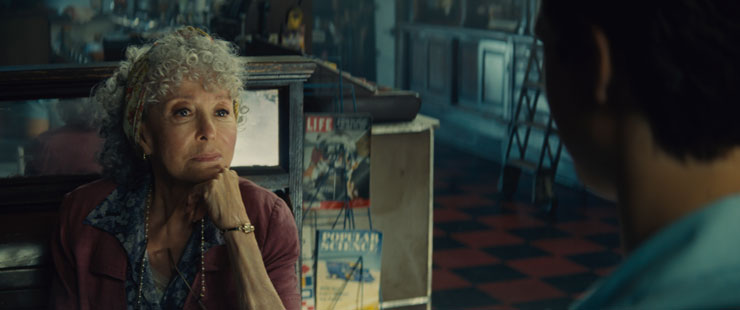
Rita Moreno as Valentina, a role written in a scene from "West Side Story." (Photo courtesy 20th Century Studios.)
The alchemy feels off. The arc of Maria and Tony's doomed relationship begins to feel more and more like an obligation. Such an inconvenient infatuation amounts to a hill of beans in this crazy world. If this notion weren't clear enough, the movie has Moreno give voice to it. “Life matters even more than love,” she says at one point.
Speak for yourself, ma'am. I like my tragic romances passionate and torrid, and in the doom-laden “West Side Story,” love means having to negotiate your feelings until they dissipate into the ether. That, and having a bucket of cold water thrown over you.
“West Side Story” is now showing in wide release in theaters across South Florida, including IMAX engagements at Regal South Beach and CMX Dolphin Mall, and IMAX and Dolby Cinema engagements at AMC Aventura and AMC Sunset Place.




